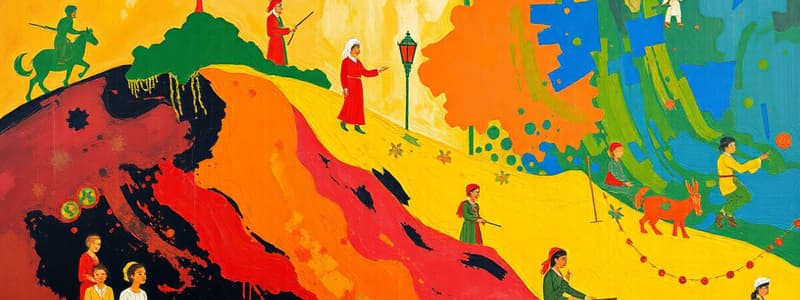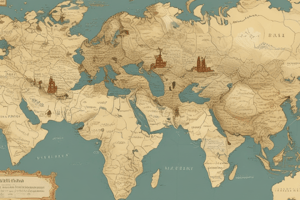Podcast
Questions and Answers
What method of trading was NOT used along the Silk Road?
What method of trading was NOT used along the Silk Road?
- Bartering
- Peddling
- Using ships (correct)
- Using currency
Which of the following goods was NOT traditionally traded along the Silk Road?
Which of the following goods was NOT traditionally traded along the Silk Road?
- Spices
- Tea
- Gold (correct)
- Jade
What was the primary reason Silk Road traders used bartering as a form of trade?
What was the primary reason Silk Road traders used bartering as a form of trade?
- To facilitate trade with different cultures (correct)
- To avoid using currency
- To ensure equal value exchange of goods
- To avoid paying taxes
Which region was the final destination for the silks traded along the Silk Road?
Which region was the final destination for the silks traded along the Silk Road?
What unique characteristic defined the trading system used along the Silk Road?
What unique characteristic defined the trading system used along the Silk Road?
What was the MAIN reason for the high interest rates charged to traders borrowing money for their Silk Road journeys?
What was the MAIN reason for the high interest rates charged to traders borrowing money for their Silk Road journeys?
What is a similarity between Silk Road trade and trade routes that relied on maritime travel?
What is a similarity between Silk Road trade and trade routes that relied on maritime travel?
What was a major difference between Silk Road trade and trade routes that relied on maritime travel?
What was a major difference between Silk Road trade and trade routes that relied on maritime travel?
What was a significant challenge traders faced when using Silk Road routes compared to sea routes?
What was a significant challenge traders faced when using Silk Road routes compared to sea routes?
What advantage did traders gain from traveling in caravans along the Silk Road?
What advantage did traders gain from traveling in caravans along the Silk Road?
Which of these goods were commonly traded from the west to the east along the Silk Road?
Which of these goods were commonly traded from the west to the east along the Silk Road?
How did traders utilize caravanserai during their journeys along the Silk Road?
How did traders utilize caravanserai during their journeys along the Silk Road?
What was a major reason for the popularity of sea trade routes in comparison to the Silk Road?
What was a major reason for the popularity of sea trade routes in comparison to the Silk Road?
What was the primary function of bazaars in cities like Bactria and Samarkand?
What was the primary function of bazaars in cities like Bactria and Samarkand?
Which of the following was NOT a reason why traders might choose to buy a variety of goods along the Silk Road?
Which of the following was NOT a reason why traders might choose to buy a variety of goods along the Silk Road?
Which of the following statements accurately compares Silk Road and sea trade routes?
Which of the following statements accurately compares Silk Road and sea trade routes?
How were the Sea Roads and the Silk Roads similar?
How were the Sea Roads and the Silk Roads similar?
What was a key difference between the Sea Roads and the Silk Roads in terms of the goods transported?
What was a key difference between the Sea Roads and the Silk Roads in terms of the goods transported?
Which of the following is NOT a reason cited in the text for the development of trade routes in the Indian Ocean?
Which of the following is NOT a reason cited in the text for the development of trade routes in the Indian Ocean?
What is the significance of the monsoon winds in the development of Indian Ocean commerce?
What is the significance of the monsoon winds in the development of Indian Ocean commerce?
What does the text suggest about the nature of trade along the Sea Roads?
What does the text suggest about the nature of trade along the Sea Roads?
Which of these goods was NOT a significant commodity traded on the Sea Roads, as mentioned in the text?
Which of these goods was NOT a significant commodity traded on the Sea Roads, as mentioned in the text?
What is the main point of the text about the Sea Roads?
What is the main point of the text about the Sea Roads?
What is the main reason, according to the text, that transportation costs were lower on the Sea Roads compared to the Silk Roads?
What is the main reason, according to the text, that transportation costs were lower on the Sea Roads compared to the Silk Roads?
Flashcards
Trade Route Advantages
Trade Route Advantages
Benefits of specific trade paths, like safety or speed.
Trade Route Disadvantages
Trade Route Disadvantages
Drawbacks of certain trade paths, like danger or length.
Caravan
Caravan
A group of traders traveling together for safety.
Caravanserai
Caravanserai
Signup and view all the flashcards
Bazaars
Bazaars
Signup and view all the flashcards
Goods from the West
Goods from the West
Signup and view all the flashcards
Goods from China
Goods from China
Signup and view all the flashcards
Estimating Expenses
Estimating Expenses
Signup and view all the flashcards
Silk Road Sections
Silk Road Sections
Signup and view all the flashcards
Eastern Section Trade
Eastern Section Trade
Signup and view all the flashcards
Central Asia Role
Central Asia Role
Signup and view all the flashcards
Peddling Trade
Peddling Trade
Signup and view all the flashcards
Bartering
Bartering
Signup and view all the flashcards
Trade Expedition
Trade Expedition
Signup and view all the flashcards
Risk of Borrowing
Risk of Borrowing
Signup and view all the flashcards
Route Selection
Route Selection
Signup and view all the flashcards
Sea Roads
Sea Roads
Signup and view all the flashcards
Indian Ocean basin
Indian Ocean basin
Signup and view all the flashcards
Monsoons
Monsoons
Signup and view all the flashcards
Transportation costs
Transportation costs
Signup and view all the flashcards
Bulk goods
Bulk goods
Signup and view all the flashcards
Cultural diversities
Cultural diversities
Signup and view all the flashcards
Navigational technology
Navigational technology
Signup and view all the flashcards
Interlocked human world
Interlocked human world
Signup and view all the flashcards
Study Notes
Introduction
- Ancient trade networks connected East Asia and the Mediterranean.
- The Silk Road was a vast network of trails and trading routes.
- Trade routes spanned 5,200 miles.
- Alternative routes existed.
- Trade was affected by political conditions in various regions.
- The Silk Road was not a single continuous route; rather, it encompassed various interconnected pathways.
Key Concepts
- Bandit: A thief
- Caravan: A group of traders traversing land together
- Catalyst: A force that causes changes
- Commerce: Trade
- Cultural diffusion: Exchange of cultural traits
- Economy: System of producing and distributing goods
- Exchange: Trading goods or services
- Goods: Products
- Globalization: The connection of countries globally
- "Indianization": Cultural assimilation
- Merchant(s): Trader(s)
- Pilgrim(s): Religious traveler(s)
- Raw material: Unprocessed resources used in manufacturing
- Sea Road(s): Maritime trade routes
- Silk Road(s): Terrestrially based trade routes
- Supply chain: Sequence of steps involved in production and distribution of goods
- Trader: Person engaged in trade
- Transregional: Involving multiple regions/countries
Historical Context
- The Silk Road existed from 200 BCE to the 16th century CE.
- It had multiple Golden Eras.
- The first Golden Era was from 200 BCE to 200 CE
- The second Golden Era was from 700 to 1000 CE
- The third Golden Era was from 1300 to 1400 CE
- The Mongol Empire facilitated trade.
- The desire for reliable trade routes led to European exploration.
- The Silk Road trade routes declined with the rise of sea routes.
The Dynamics of Trade along the Silk Road
- Silk Road trade involved valuable goods like silk, precious stones, glass, and dyes.
- The Silk Road's geography was divided into three sections (eastern, Central Asian, and western).
- Trades occurred by exchanging goods.
- Merchants traveled in caravans.
- Merchants traded along the Silk Road or between regions and cities.
- The three major segments comprised a network of connected trade routes which spanned the width of Eurasia.
Impact of the Silk Road
- Spread of culture, ideas, and religions
- Exchange of plants and food
- Technological innovations along the Silk Road
- The spread of Buddhism and other religions
- Exchange of technologies among different cultures, facilitated the spread of paper, gunpowder, and printing
- Diffusion of Buddhism from India to China
- Transmission of the techniques for making silk
- Cultural diffusion of food and agriculture
Studying That Suits You
Use AI to generate personalized quizzes and flashcards to suit your learning preferences.



